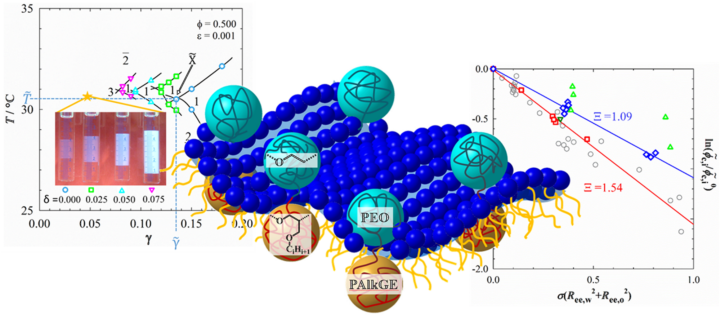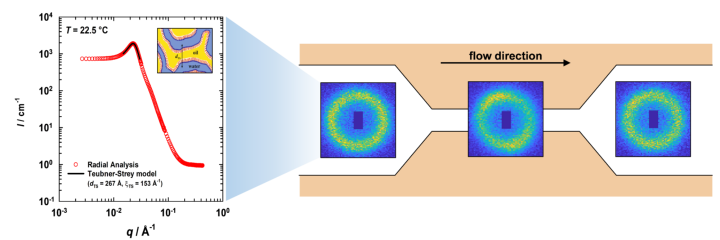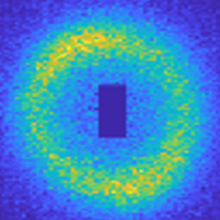Overview
This topic deals with complex self-assembled systems which are formed either by addition of amphiphilic block copolymers or by application of flow to nano-structured systems such as microemulsions. Methods used to characterize the structure of these systems are scattering methods, e.g. static or dynamic light scattering (SLS or DLS) and small-angle neutron scattering (SANS), as well as NMR self-diffusion.
In previous studies, it was found that polymers of the type poly(ethylene propylene)-co-poly(ethylene oxide) can induce an enormous efficiency boosting effect in microemulsion systems [1]. Therefore, in one of our studies we examined the efficiency boosting effect of a new type of polyether-polycarbonate block-co-polymers (mPEG-b-PBC) in microemulsion systems. These novel block copolymers, which are accessible from inexpensive materials via a simple and solvent-free polymerization using CO2, were synthesized by the group of Prof. Dr. H. Frey (Department of Chemistry, Johannes Gutenberg University Mainz). We were able to show that these block copolymers boost the efficiency of medium-chain surfactants when technically relevant polar oils, e.g. ether and ester oils, have to be solubilized in an emulsion or a microemulsion [2].

Similarly, the Frey group synthesized new diblock copolymers of the type poly(ethylene oxide)-poly(alkyl glycidyl ether), namely mPEO-b-PAlkGE and the technical component-based, CO2-containing mPEO-b-PCO2AlkGE. These polymers exhibit a strong boosting effect in different H2O/NaCl – oil – non-ionic surfactant systems. The boosting can not only be observed with medium-chain surfactants/oils, but also in systems containing long-chain oils and technical-grade waxes and surfactants. The so-called membrane model [3, 4] can be used to scale the efficiency boosting of different polymers based on the number density of polymers in the membrane and the polymer blocks’ end-to-end distances [5]. For microemulsions at room temperature containing medium-chain n-alkanes, our data are in good agreement with PEO-PEP literature data [6]. However, for long-chain oil microemulsions stable at elevated temperatures, altered polymer-oil-surfactant interactions seem to influence the scaling.

In another project with Prof. Dr. João T. Cabral (Imperial College London, Department of Chemical Engineering) and Lionel Porcar (Institut Laue-Langevin, Grenoble), we study the structural influence of flow on bicontinuously structured microemulsions via the Microfluidic-SANS method [7]. The chosen standard microemulsion system shows a bicontinuous-to-lamellar transition with increasing surfactant concentration at the phase inversion temperature located near room temperature, i.e. PIT = 22.5 °C. Furthermore, the scattering experiments reveal the emergence of an anisotropic scattering pattern under certain flow conditions (Fig. 3). Our main goal is trying to understand the physical reasons for this transition as well as the morphology of the induced structure.

References
- Jakobs, B., Sottmann, T., Strey, R., Allgaier, J., and Richter, D.: Amphiphilic Block Copolymers as Efficiency Boosters for Microemulsions. Langmuir. 15, 6707–6711 (1999). https://doi.org/10.1021/la9900876
- Kunze, L., Tseng, S.-Y., Schweins, R., Sottmann, T., Frey, H.: Nonionic Aliphatic Polycarbonate Diblock Copolymers Based on CO2, 1,2-Butylene Oxide, and mPEG: Synthesis, Micellization, and Solubilization. Langmuir. 35, 5221–5231 (2019). https://doi.org/10.1021/acs.langmuir.8b04265
- Hiergeist, C., Lipowsky, R.: Elastic properties of polymer-decorated membranes. Journal de Physique II. 6. 1455-1481 (1996). https://doi.org/10.1051/jp2:1996142
- Endo, H., Mihailescu, M., Monkenbusch, M., Allgaier, J., Gompper, G., Richter, D., Jakobs, B., Sottmann, T., Strey, R., Grillo, I.: Effect of amphiphilic block copolymers on the structure and phase behavior of oil–water-surfactant mixtures. The Journal of Chemical Physics. 115, 580–600 (2001). https://doi.org/10.1063/1.1377881
- Jakobs, B.: Amphiphile Blockcopolymere als "Efficiency Booster" für Tenside: Entdeckung und Aufklärung des Effektes. Dissertation, Universität zu Köln, Cuvillier Göttingen (2002). ISBN: 9783898734370
- Schneider, K., Verkoyen, P., Krappel, M., Gardiner, C., Schweins, R., Frey, H., Sottmann, T.: Efficiency Boosting of Surfactants with Poly(ethylene oxide)-Poly(alkyl glycidyl ether)s: A New Class of Amphiphilic Polymers. Langmuir. 36, 9849--9866 (2020). https://doi.org/10.1021/acs.langmuir.0c01491
- Lopez, C., Watanabe, T., Martel, A., Porcar, L. and Cabral, J.T.: Microfluidic-SANS: flow processing of complex fluids. Scientific Reports. 5, 7727 (2015). https://doi.org/10.1038/srep07727
- Teubner, M. and Strey, R.: Origin of the scattering peak in microemulsions. The Journal of Chemical Physics. 87, 3195-3200 (1987). https://doi.org/10.1063/1.453006
Cooperations
- Prof. Dr. Holger Frey, Department of Chemistry, Johannes Gutenberg University Mainz, Germany
- Prof. Dr. João T. Cabral, Department of Chemical Engineering, Imperial College London, United Kingdom
- Lionel Porcar, Group of Large Scale Structures, Institut Laue-Langevin, Grenoble, France

Maximilian Krappel
Doctoral Researcher

Julian Fischer
Doctoral Researcher

Thomas Sottmann
Prof. Dr.Professor


